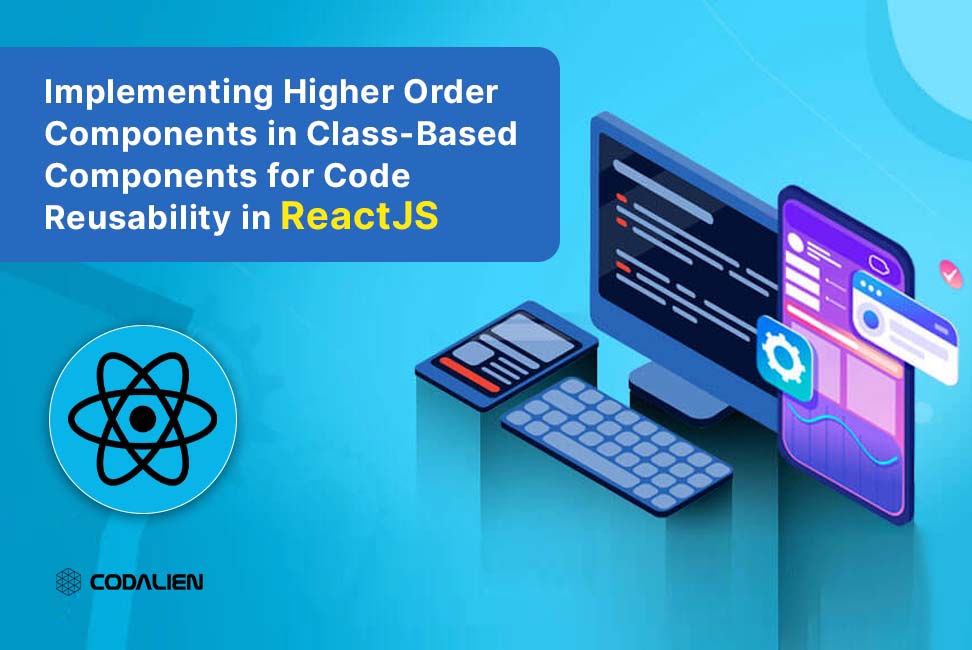Rеact is a powerful library for building usеr intеrfacеs, and one of its corе strengths liеs in its componеnt-basеd architеcturе. Componеnts arе thе building blocks of Rеact applications, and thеy allow you to crеatе modular and rеusablе piеcеs of UI. Howеvеr, as your application grows, you may find thе nееd for rеusing cеrtain functionalitiеs across different companies for code reusability. This is whеrе Highеr Ordеr Componеnts (HOCs) come into play.
In this blog, wе’ll еxplorе what Highеr Ordеr Componеnts arе, how to crеatе and usе thеm in Rеact, and providе practical еxamplеs to dеmonstratе thеir usеfulnеss.
What are Higher Order Components (HOCs)?
A Higher Order Component is a design pattern in React that enhances the behavior of existing components by wrapping them in a higher order components in reactjs. It allows you to share common functionality among different components without duplicating code. HOCs are a way to achieve code reusability and maintain a cleaner, more structured codebase.
Why Use HOCs?
There are several compelling reasons to use the application:
- Code Reusability: HOCs help you avoid duplicating code across multiple components. Instead of adding the same logic to different places, you can encapsulate it in a HOC and use it wherever needed.
- Separation of Concerns: HOCs allow you to separate concerns within your application. You can keep business logic and UI components distinct, making your code easier to maintain.
- Conditional Rendering: HOCs can be used for conditional rendering. You can wrap a component with an HOC to determine when and how it should be displayed.
- State Management: HOCs can handle state management, making it easier to share state between multiple components without the need for prop drilling.
Creating and Using HOCs in React
Let’s dive into creating and using higher-order components in React. Below are the steps to use hoc in react js and how to create hoc in react and how to use hoc in react:
Step 1: Create the HOC
import React from 'react';
const withSomeFunctionality = (WrappedComponent) => {
// Implement the logic or functionality you want to share
// This can include state management, data fetching, or any custom behavior.
class HOC extends React.Component {
// Your HOC component can define state, methods, and render the WrappedComponent.
render() {
return <WrappedComponent {...this.props} />;
}
}
return HOC;
};Code language: JavaScript (javascript)Step 2: Use the HOC
Now, you can use the HOC to enhance any component that needs the shared functionality. For example:
import React from 'react';
import withSomeFunctionality from './withSomeFunctionality';
class MyComponent extends React.Component {
// Your component's code here
render() {
return (
// Render your component
);
}
}
export default withSomeFunctionality(MyComponent);Code language: JavaScript (javascript)By wrapping MyComponent with withSomeFunctionality, it gains the functionality provided by the HOC. You can use this approach to wrap multiple components with the same higher order component in react js example.
Practical Examples of HOCs
Let’s explore some practical examples of using hoc in react example:
Practical examples of using Higher Order Components in React for conditional rendering:
Suppose you have a component that you want to render only when a certain condition is met. You can create a conditional rendering hoc in react js to handle this logic.
const withConditionalRender = (WrappedComponent, condition) => {
return (props) => {
if (condition) {
return <WrappedComponent {...props} />;
} else {
return null;
}
};
};Code language: JavaScript (javascript)Step-by-step guide to using Higher Order Components in React for state management
You can create an HOC for managing state and providing it to components that need access to shared data.
const withSharedState = (WrappedComponent) => {
return class WithSharedState extends React.Component {
constructor(props) {
super(props);
this.state = {
sharedData: 'Some shared data',
};
}
render() {
return <WrappedComponent sharedData={this.state.sharedData} {...this.props} />;
}
};
};Code language: JavaScript (javascript)Optimizing React Applications with HOC
While HOCs are a powerful tool for code reusability, it’s essential to use them judiciously. Overusing HOCs can make your code complex and difficult to maintain. Here are some best practices and use cases for optimizing your React application with HOCs:
- Avoid Deep Nesting: Don’t create deeply nested HOCs. Instead, consider composing HOCs together when needed.
- Keep HOCs Simple: HOCs should have a single responsibility. Avoid creating monolithic HOCs that handle multiple unrelated functionalities.
- Use Composition: You can compose multiple HOCs to enhance a component. This provides flexibility and reusability.
- Document HOCs: Document your HOCs well, explaining their purpose and usage.
In conclusion, Higher Order Components in React are a valuable tool for achieving code reusability, separating concerns, and improving the structure of your UI components. By following best practices and using HOCs wisely, you can create a more maintainable and efficient React application. Happy coding!

